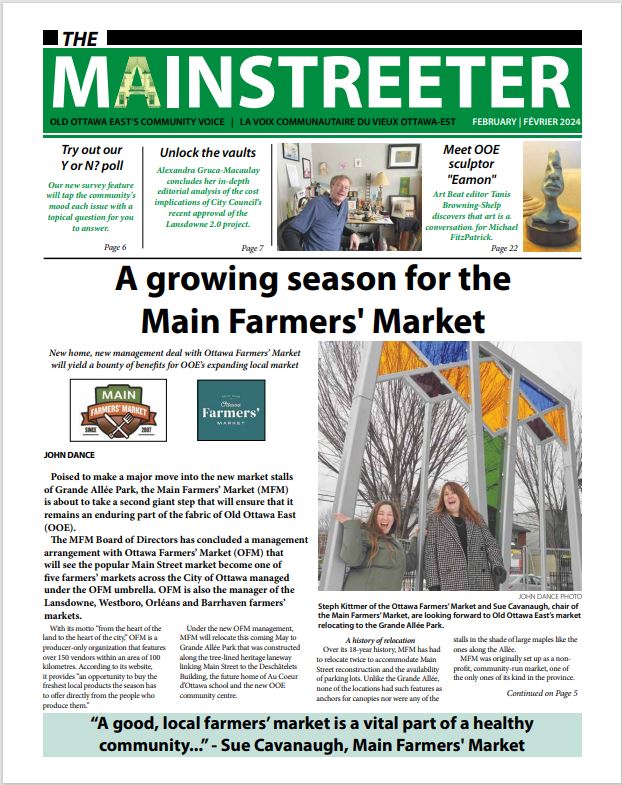Thoughts on very large houses in Old Ottawa East
John Dance
Over the last 10 years, Old Ottawa East has seen a lot of rebuilding whereby old houses have been torn down and replaced by much larger homes. This transformation reflects a trend across Canada where, since the 1970s, the average size of a new house has doubled to about 2,000 square feet.
The question is whether this is a desirable trend.
During these pandemic days, the extra space may be enjoyed. It certainly is a marked contrast to what, say, residents of the Lees Avenue apartment buildings have experienced, let alone how the homeless are coping.
But are the much larger homes – some of them “monster homes” – good for our community, its fabric, and the environment? Should the City of Ottawa’s planning policies be modified?
In the case of most of these new homes built on lots where a house was demolished, there is no increase in density. Indeed, given the changes in family demographics, many of the larger new homes have fewer residents than used to live in the smaller homes.
So the City can’t plausibly justify the new homes on the basis of achieving intensification.
If the much larger homes were built in accordance with zoning restrictions then it wouldn’t be bad, but often so called “minor variances” are approved by the City so that prescribed yard requirements are reduced, or the building height is increased, or both.
And not only is more of the lot taken up by the new house, but there is more hard-surface around it, so that there is less room for trees, and less precipitation is able to soak into the ground to nourish those trees. Let’s not forget how trees are often removed so that the new houses can be built, or how trees on neighbouring properties suffer damage during the construction.
Many of the new homes have roof-top terraces and balconies that reduce the privacy of neighbours and increase the general level of noise in the summer.
With the larger homes comes the reality that it is harder to afford a home in Old Ottawa East. We’re not going to become Rockcliffe Park, but we are going to have fewer economically diverse residents.
So, what options might be explored? First, perhaps houses in the centre of the City should have a maximum floor area. We have no problem with the idea of limits on height, so why not on floor area? If people want to have really large homes let them move to an area where there are large lots and fewer neighbours.
Maybe policies should be changed so that two small – and affordable – houses can be built on what was a single lot. Or perhaps there should be changed zoning so that the modest – yet dense – two-storey row housing like that of Terra Firma on Drummond Street is allowed. Another idea is to add to the so-called “tests” of the minor variance process, for example, a new test to determine whether the proposed variance has an adverse impact on trees.
The pandemic has already changed the world. Maybe it’s time to figure out how we can reduce the amount of housing excess in our community. Perhaps we should actively encourage modest homebuilding for more people, achieved in a manner that is environmentally sensitive and actually addresses climate change.
On expanding the urban boundary
.
Jamie Brougham
A silver lining of this pandemic is that in responsible communities, people are getting out in their community. They want to escape their house. To many, all of a sudden, the kind of community they live in matters a lot more.
The 15-minute rule is great, that is, where you can walk to in 15 minutes from your house. Hopefully, that radius affords you with everything you need: groceries, natural settings like parks and shady wooded paths, places to live, work, and play.
In Old Ottawa East, we are very fortunate for the efforts of community members who stand up and say what kind of community they want, residents who have created a vision for the future and are willing to stand up for that vision? Just think about the results. If we left it to others, for example, at the City, well they won’t care if you don’t. You can be sure our community would be four lanes up and down Main Street.
Because of engaged community members’ efforts, there is good connectivity throughout our neighbourhood, including the Flora Footbridge. There have been countless meetings where your neighbours have stood up to question the social benefit of every proposed development. If they didn’t stand up for us, we’d get far more housing, less social amenities, and less space for a better quality of life.
While the City talks about expanding the boundary, I can go either way. If urban intensification brings parks, social amenities, necessary businesses, and good quality of life, then I’m for it. In these pivotal times, I’d like to see our political “leaders” have two-way communication with us about a vision for the future and how we can participate in achieving shared goals.
The example of the City’s urban boundary expansion the question, which only addresses volume – quantity not the quality of life, demonstrates why communities have to have a voice. The discussion must relate primarily to issues of quality and questions of volume will have to be secondary. Old Ottawa East is an example of why the right focus builds the best communities!
Public toilets
Where to go when there’s no place to go?
Bessa Whitmore
More than ever, COVID-19 has made clear that a network of clean, safe and accessible public toilets is fundamentally a public health issue.
Recent media attention to truckers, taxi or uber drivers, bus drivers, garbage collectors, delivery persons, journalists, photographers and anyone doing essential jobs that involve moving around the city, has highlighted this problem. What are they supposed to do when the public toilets that do exist are all closed during this pandemic? Normally, these people use public toilets or facilities at businesses (cafes, eateries), but these are now closed as well.
People who are homeless have always had a problem, but it’s worse now that there is ‘no place to go.’ This includes access to water for handwashing, something we are told to do frequently. For many people experiencing homelessness, access to clean running water and disinfectants is not a given. They may need to walk several city blocks or further to reach the nearest public restroom.
And then there’s the rest of us. While being told to stay home, we’re also encouraged to go out for walks to get exercise and fresh air. What to do when we need a toilet? Can we tell a small child to ‘hold it’ until they get home? Must such walks be unavailable to those with chronic diseases, such as Crohn’s and Colitis, that require readily available facilities? Menstruating women caught short? Older adults whose bladders require more frequent attention?
Recently, the National Capital Commission opened Queen Elizabeth Drive for walkers and bikers, a positive move. But there are no public toilets – and facilities at Patterson Creek and the Canal Ritz, for example, are generally closed. And even when these facilities are open, there is no signage.
The banality of the subject means we don’t often consider public toilets as a basic human right as they should be. Arguments exist for the human right to shelter, food and water in the city — but what happens after that? Toilets are something everybody needs (https://thetyee.ca/Culture/2019/08/29/Real-Cities-Have-Washrooms/).
Why is building and maintaining roads considered an unquestionable necessity and legitimate expense, but having public toilets is deemed a superfluous luxury, asks Andre Picard (https://www.theglobeandmail.com/opinion/when-you-gotta-go-but-theres-no-public-toilet-in-sight/article35782108/)? The answer is not to refuse to build public toilets, it is to value and maintain them as any other public infrastructure.
In Canada, according to Picard, we behave as if urination, defecation and menstruation are not routine bodily functions, but are somehow optional if we are away from our homes. Toilets need to be considered a No. 1 (and No. 2) priority of urban design; they are essential for an inclusive, healthy society. We design, construct and maintain public spaces such as roads, sidewalks and parks, but act as if people using those spaces will never need toilet facilities unless they are attending an “event” such as Canada Day.
What’s the most intimate way you engage with your city’s architecture? Answer: when you go to the toilet. Real cities give their people places to pee (https://thetyee.ca/Culture/2019/08/29/Real-Cities-Have-Washrooms/).
The GottaGo! Campaign has been advocating for a network of clean, safe and accessible, public toilets in Ottawa since 2014. Though there have been some notable successes (e.g.: public toilets in the node stations of the LRT; porta potties at some splash pads and sports fields), our pleas have been pushed aside as too expensive, an ‘extra’ compared to other infrastructure.
And, here we are, in the midst of an historic pandemic. Maybe this is what it takes to get some serious attention to the issue of public health, including toilets. A crisis can be an opportunity, so now is the time for all of us to advocate for a network of public toilets, to include running water and soap for handwashing.
![]() For the past six years, the GottaGo! campaign has been pressuring the City of Ottawa and the National Capital Commission to do something about this issue. If you wish to help advocate for a network of clean, safe and accessible public toilets in the City of Ottawa, visit the GottaGo! website at https://www.ottawapublictoilets.ca.
For the past six years, the GottaGo! campaign has been pressuring the City of Ottawa and the National Capital Commission to do something about this issue. If you wish to help advocate for a network of clean, safe and accessible public toilets in the City of Ottawa, visit the GottaGo! website at https://www.ottawapublictoilets.ca.






